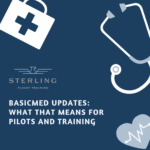Has it been a while since you’ve flown? Despite your pilot license never expiring, you must keep current with a flight review and renewed medical certificate every two years to stay legal. If you plan to fly with passengers then you are also required to complete three take off and landing cycles every 90 days, with additional guidelines in place for night-time and IFR flying.
Are you lapsed in these requirements? Don’t worry, you’re not alone. According to AOPA, there are more than 500,000 inactive pilots in the United States.
However, returning to the skies is easier than you might think. A common misconception is that you must retake your written exam or checkride with a Designated Pilot Examiner (DPE) – that’s not true.
Here are five steps to take to get started flying again.
- Assess Your Personal Health and Fitness.
The first step for many pilots is to obtain an updated medical certificate. If you think you may no longer qualify for a medical certificate, be sure to check again. What may have been disqualifying in earlier years could be acceptable with revised FAA waivers and special-issuance guidelines. See the AME guide for more details. You could also qualify to fly under BasicMed, which allows a pilot to fly without holding a medical certificate as long as certain requirements are met. - Find the Right Instructor
FAA studies show that you will most likely lose motor skills before knowledge after a lapse in flying, so it is important to conduct refresher training before your flight review. Find a CFI that understands your situation and is willing to take the time to make you feel comfortable and confident in the cockpit again. Remember one-size doesn’t fit all – your focus should be on proficiency and confidence rather than length of time. - Get Up-to-Date on Regulatory Changes
Depending on how long you’ve been away from the flying game, your knowledge of regulations may be outdated. Give special attention to Special Flight Rules Areas (SFRA), Flight Restricted Zones (FRZ), and Temporary Flight Restrictions (TFR). TFRs can pop up unexpectedly, so before any flight, be sure to check the TFR list online. - Conduct a Flight Review
Once you are confident in your skills, the next step is to schedule a Flight Review with a CFI. This generally consists of a minimum of 1-hour flight training and 1-hour ground training. Upon completion the instructor will signoff on your log, marking you legal once again. - Maintain Proficiency
Becoming legal to fly again means you can get back in the air, but it doesn’t necessarily mean that you are proficient as possible. Maintaining proficiency and staying safe means you need to continue practicing and monitoring aviation changes. Consider extending your 90-day currency requirements to include more flight time outside of the three landings and takeoffs or conduct a flight review with an instructor more frequently than the 24 month requirement. For IFR-rated pilots, the FAA recommends flying with a CFII at least once a month with an emphasis on flying in actual conditions to remain proficient.
Ready to get back in the air? We can help you determine a training plan and conduct your review at Sterling Flight Training. Contact us today.





